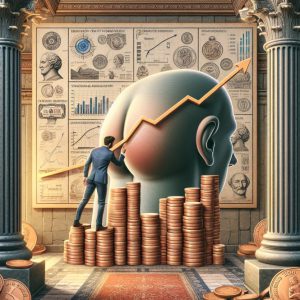Why Is Inflation Bad for the Economy?
Apr 14, 2023
Inflation is a complex economic phenomenon that is often difficult to understand. Many people believe that inflation is simply a price rise, but it is much more than that. Inflation can have serious economic consequences and lead to higher levels of poverty and inequality.
The Illusion of the Phillips Curve
The Phillips Curve is a concept that suggests a trade-off between unemployment and inflation. It posits that as unemployment falls, inflation rises, and vice versa. This theory has been widely accepted in economics and used to guide monetary policy decisions. However, recent trends have challenged the validity of the Phillips Curve, leading some economists to question its usefulness.
The Limitations of the Phillips Curve in Today’s Global Economy
One of the main challenges to the Phillips Curve is the phenomenon of low wage growth despite low unemployment rates. In the past, low unemployment rates were associated with higher wage growth, as employers had to compete for a limited pool of workers. However, despite low unemployment rates, wage growth has remained stagnant in recent years. This suggests that the relationship between unemployment and wage growth is not as straightforward as the Phillips Curve suggests.
The Impact of Globalization on the Phillips Curve
Another challenge to the Phillips Curve is the impact of globalization on inflation. As the global economy has become more interconnected, the prices of goods and services have become more closely linked across countries. This means that changes in domestic unemployment rates may impact inflation less than they did in the past. For example, if a country experiences a period of low unemployment, but global competition keeps prices low, inflation may not rise as much as the Phillips Curve would predict.
Furthermore, the Phillips Curve assumes that there is a stable relationship between unemployment and inflation. However, this relationship may change over time due to changes in the economy or shifts in policy. For example, if the government implements policies encouraging investment and job creation, unemployment may fall without causing inflation to rise.
Despite these challenges, the Phillips Curve remains a valuable tool for understanding the relationship between unemployment and inflation. However, it is essential to recognize its limitations and use it with other economic indicators and models. Policymakers should not rely solely on the Phillips Curve to guide their decisions but should consider various factors when making monetary policy decisions.
Comprehensive Economic Analysis: Why It Matters
The Phillips Curve proposes a correlation between inflation and unemployment, indicating a potential trade-off between the two factors. However, recent trends have challenged the validity of this theory, leading some economists to question its usefulness. While the Phillips Curve remains a valuable tool for understanding the relationship between unemployment and inflation, it is essential to recognize its limitations. It should be used in conjunction with other economic indicators and models. Policymakers should not rely solely on the Phillips Curve to guide their decisions but should consider various factors when making monetary policy decisions.
The Negative Impact of Inflation on Wages
The International Labour Organization (ILO) warns that inflation is affecting the purchasing power of the middle class and hitting low-income households the hardest. The Global Wage Report 2022-2023 estimates that global monthly wages fell by minus 0.9% in real terms in the first half of 2022, marking the first time in a century that real global wage growth has been negative.
Real wages in advanced G20 countries declined to minus 2.2% in the first half of 2022, while real wages in emerging G20 countries grew by only 0.8%, 2.6% less than in 2019, the year before the COVID-19 pandemic. Gilbert F. Houngbo, the ILO Director-General, warns that declining real wages will increase income inequality and poverty, risking the post-pandemic recovery and fuelling social unrest worldwide. He stresses that maintaining the purchasing power of the lowest-paid workers is crucial for achieving prosperity and peace for all.
Beating Inflation: Investing in Assets to Protect Your Wealth
Inflation can have serious economic consequences, so understanding why inflation is bad for the economy is crucial. Despite low unemployment rates, workers face cuts in their real pay due to inflation, which affects the purchasing power of the middle class and hits low-income households the hardest. The negative impact of inflation on wages can lead to increased income inequality and poverty, risking the post-pandemic recovery and fuelling social unrest worldwide. Astute investors can beat the effects of inflation by investing in the stock market, precious metals, commodities, and other assets that have historically proven to be good hedges against inflation.
Gold, for instance, has long been considered a store of value and a safe haven asset during times of inflation. Similarly, real estate investments and equities of companies that benefit from rising prices and inflation can protect against the effects of inflation. In conclusion, understanding why inflation is bad for the economy is crucial. Maintaining the purchasing power of the lowest-paid workers is essential to achieve long-term prosperity and peace for all. Investors can Trump the effects of inflation by diversifying their portfolios and investing in assets that historically have proven to be good hedges against inflation.
Conclusion
Inflation is more than just a price rise; it can have serious economic consequences, leading to higher levels of poverty and inequality. The Phillips Curve, a widely accepted economic concept, suggests a trade-off between unemployment and inflation. However, recent trends have challenged its validity, leading some economists to question its usefulness. The impact of globalization on inflation and the assumption of a stable relationship between unemployment and inflation are some of the challenges to the Phillips Curve.
Despite its limitations, it remains a valuable tool for understanding the relationship between unemployment and inflation. However, policymakers should not rely solely on it to guide their decisions. The negative impact of inflation on wages can lead to a decline in global monthly wages, increased poverty, and inequality.
Maintaining the purchasing power of the lowest-paid workers is crucial to achieving long-term prosperity and peace for all. Astute investors can beat the effects of inflation by investing in assets that have historically proven to be good hedges against inflation, such as gold, real estate, and equities of companies that benefit from rising prices and inflation.
Summary
Workers are facing cuts in their real pay despite low unemployment rates
The Global Wage Repor 2022-2023 estimates that real global wage growth has been negative for the first time in a century
Inflation is affecting the purchasing power of the middle class and hitting low-income households the hardest
This can lead to increased income inequality and poverty
It is crucial to maintain the purchasing power of the lowest-paid workers to achieve prosperity and peace for all
FAQs
| Question | Answer |
|---|---|
| What is inflation, and why is it bad for the economy? | Inflation is a complex economic phenomenon that can have serious economic consequences, leading to higher levels of poverty and inequality. It is more than just a price rise; it affects the purchasing power of the middle class and hits low-income households the hardest. |
| What is the Phillips Curve, and why is it important? | The Phillips Curve is a widely accepted economic concept that suggests a trade-off between unemployment and inflation. It posits that as unemployment falls, inflation rises, and vice versa. It is important because it has been used to guide monetary policy decisions. |
| What are the limitations of the Phillips Curve in today’s global economy? | One of the main challenges to the Phillips Curve is the phenomenon of low wage growth despite low unemployment rates. The impact of globalization on inflation and the assumption of a stable relationship between unemployment and inflation are some of the challenges to the Phillips Curve. |
| How can investors beat the effects of inflation? | Astute investors can beat the effects of inflation by investing in assets that have historically proven to be good hedges against inflation, such as gold, real estate, and equities of companies that benefit from rising prices and inflation. |
| Why is maintaining the purchasing power of the lowest-paid workers crucial for achieving long-term prosperity and peace for all? | The International Labour Organization (ILO) warns that declining real wages will increase income inequality and poverty, risking the post-pandemic recovery and fuelling social unrest worldwide. Maintaining the purchasing power of the lowest-paid workers is essential to achieve long-term prosperity and peace for all. |
| Should policymakers rely solely on the Phillips Curve to guide their decisions? | No, policymakers should not rely solely on the Phillips Curve to guide their decisions. It should be used in conjunction with other economic indicators and models. |
Articles You’ll Love: Our Top Picks for Curious Minds

The Yen ETF: A Screaming Buy for Long-Term Investors

Is Value Investing Dead? Shifting Perspectives for Profit

What Happens If the Market Crashes? Smart Moves vs. Panic Runs

Logical vs. Emotional Thinking: Deciphering the Dominant Force

Financial Mastery: Time in the Market Trumps Timing

What is Hot Money: Unraveling the Significance and Endurance

Stochastic Calculus: Math’s Secret Weapon to Defeating the Stock Market

Bayes’ Theorem: Boost Your Investing Returns

Inflation or Deflation: Who’s Really in Control?

Deep Value Investing: Forget That, Focus on Smart Moves

According To Emergent Norm Theory, Crowds Are Filled With Folly

Volatility Harvesting: The Badass Guide to Rock It

Is Inflation Bad for the Economy? Only if You Don’t Know the Truth

Contagion Theory: Unleashing Market Mayhem Through Panic

What is the Minsky Moment? How to Capitalize on It



